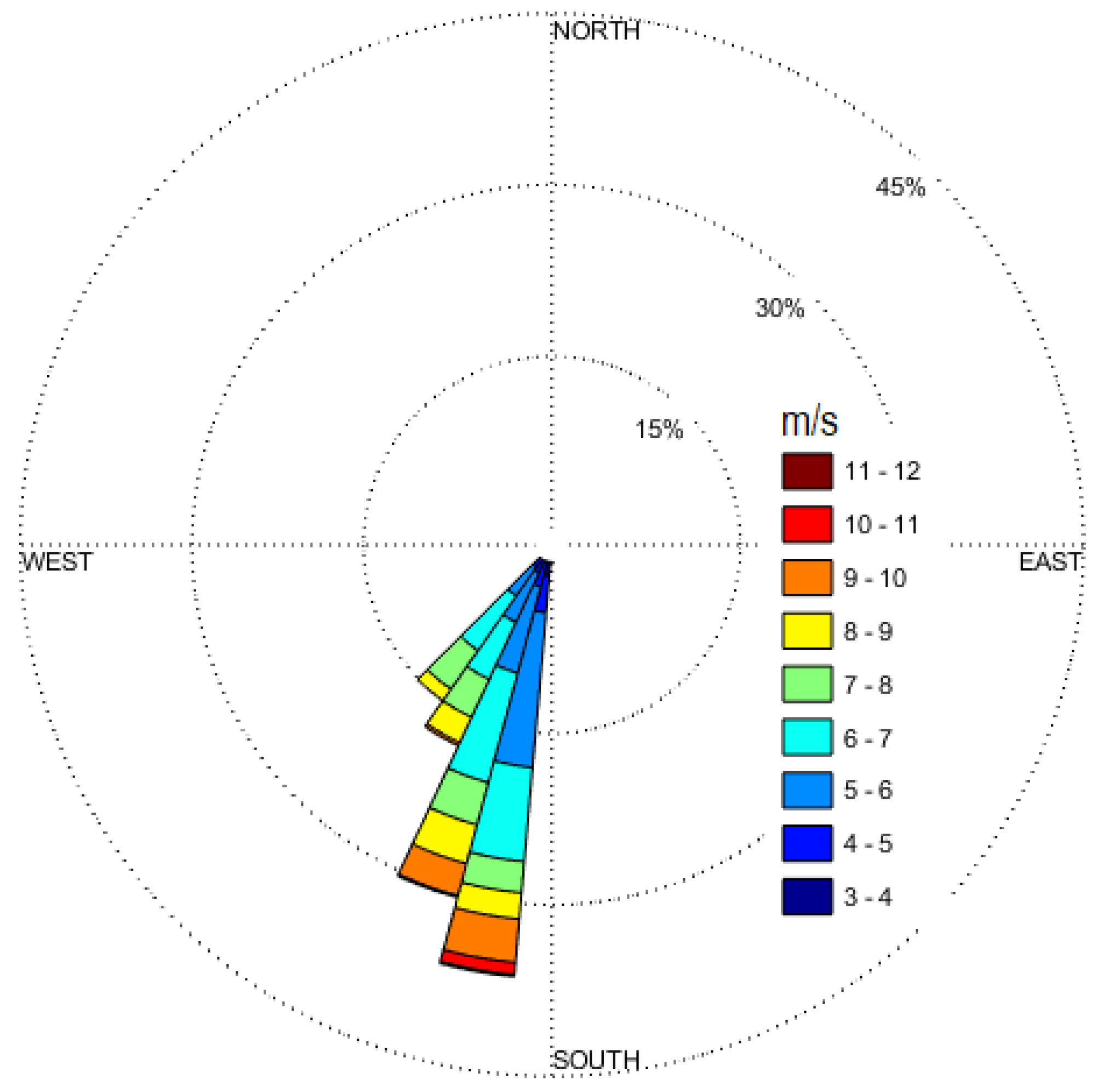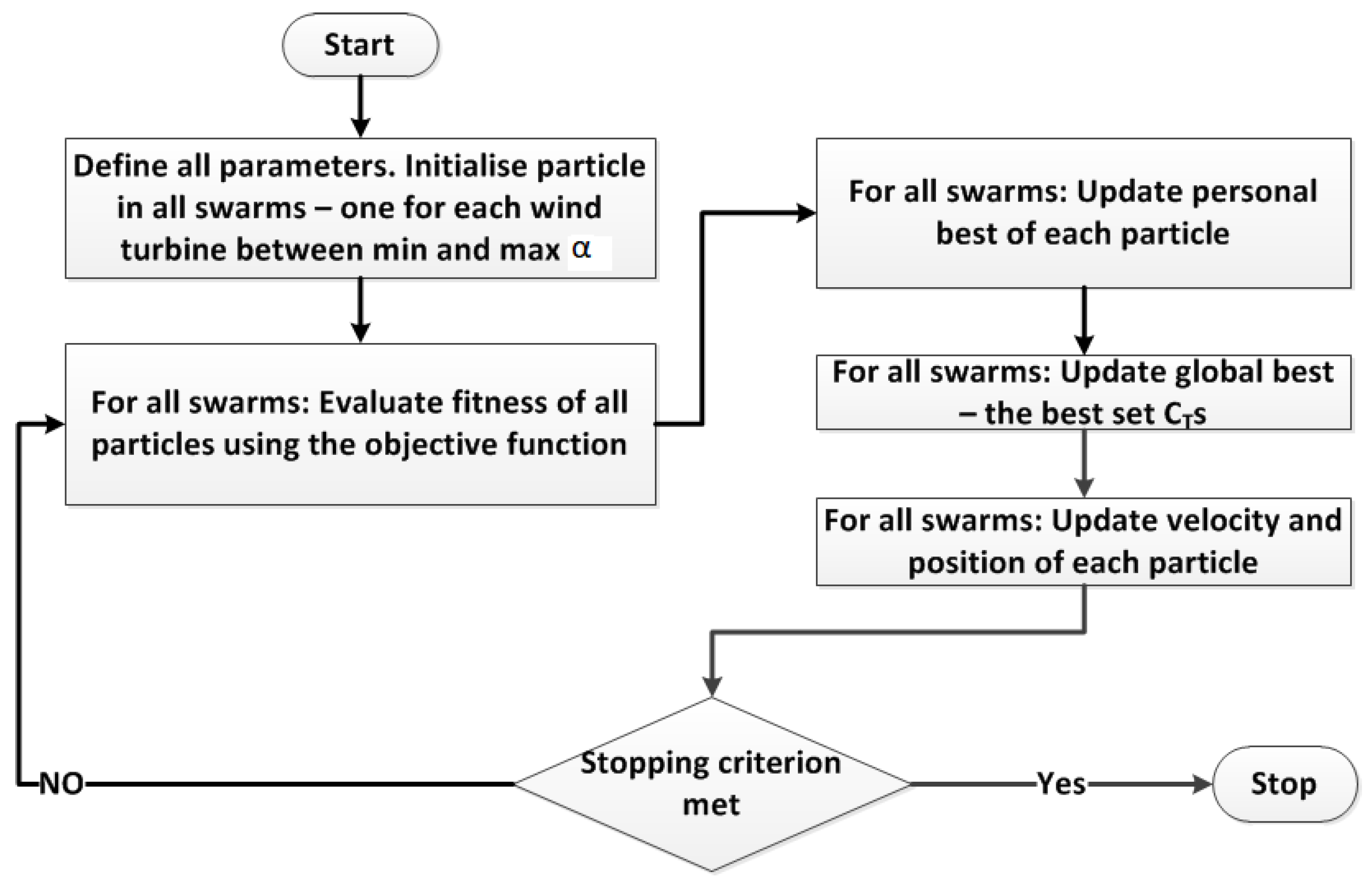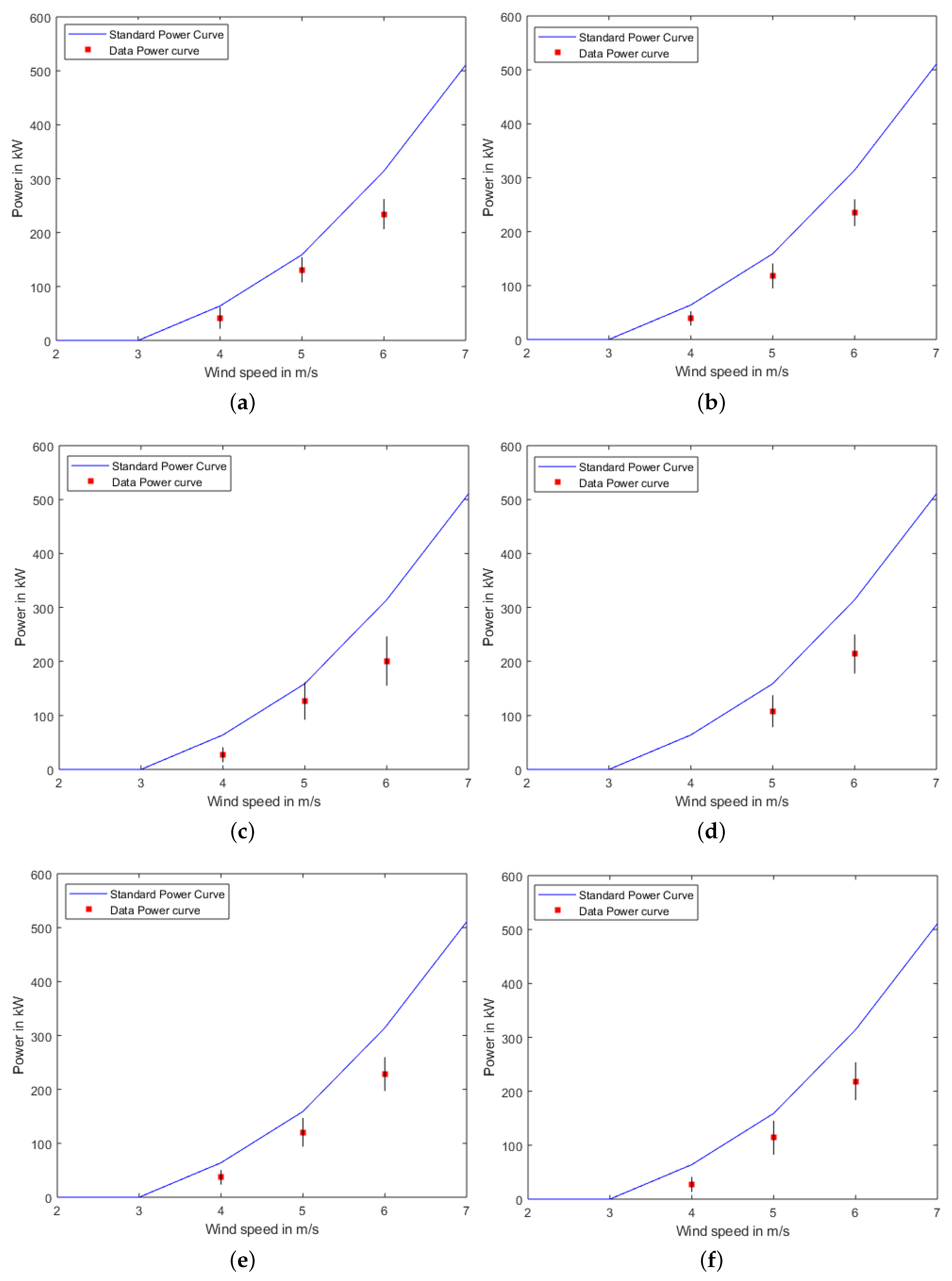Implementation and Analyses of Yaw Based Coordinated Control of Wind Farms
Abstract
:1. Introduction
2. Literature Review
3. Experimental Setup
4. Methodology
4.1. Data and Filtering
- Wind speed bin: Wind speed bin is kept at m/s.
- Wind direction bin: Wind direction bin is maintained at °.
- Yaw offset bin: Yaw offset applied on SMV6 is distributed in a bin of °.
4.2. Optimal Yaw Offsets
5. Results and Analyses
5.1. Impact of on SMV6 Production
5.2. Impact of on Net Production
5.2.1. 180°–190°
5.2.2. 191°–200°
5.2.3. 201°–210°
5.2.4. 211°–220°
6. Conclusions
Author Contributions
Funding
Conflicts of Interest
Abbreviations
| SMV | Le Sole de Moulin Vieux |
| CFD | Computational Fluid Dynamics |
| m/s | meter per second |
| kW | kilo Watt |
| MW | Mega Watt |
| ECN | Energy Research Center of the Netherlands |
| SOWFA | Simulator fOr Wind Farm Applications |
| FLORIS | FLOw Redirection and Induction in Steady-state |
| GA | Genetic Algorithm |
| PSO | Particle Swarm Optimisation |
| SCADA | Supervisory Control And Data Acquisition |
| TI-JM | Turbulence Intensity based Jensen Model |
References
- Ahmad, T.; Coupiac, O.; Pettit, A.; Guignard, S.; Girard, N.; Kazemtabrizi, B.; Matthews, P. Field Implementation and Trial of Coordinated Control of Wind Farms. IEEE Trans. Sustain. Energy 2018, 9, 1169–1176. [Google Scholar] [CrossRef]
- Ahmad, T.; Basit, A.; Anwar, J.; Coupiac, O.; Kazemtabrizi, B.; Matthews, P. Fast Processing Intelligent Wind Farm Controller for Production Maximisation. Energies 2019, 12, 544. Available online: https://www.mdpi.com/1996-1073/12/3/544/htm (accessed on 17 February 2019). [CrossRef]
- Njiri, J.G.; Söffker, D. State-of-the-art in wind turbine control: Trends and challenges. Renew. Sustain. Energy Rev. 2016, 60, 377–393. [Google Scholar] [CrossRef]
- Wagenaar, J.; Machielse, L.; Schepers, J. Controlling wind in ECN’s scaled wind farm. Proc. Eur. Prem. Wind Energy Event 2012, 1, 685–694. [Google Scholar]
- Michael, K.; Lixian, L.; Parveen, R.; Nilabh, S. Wind Farm Wake Loss Analysis and Mitigation Techniques. 2017. Available online: https://pdfs.semanticscholar.org/presentation/14a3/eaccbd0b611a38239f6dcd0dadd9396e8a84.pdf (accessed on 17 February 2019).
- Gebraad, P.; Teeuwisse, F.; Van Wingerden, J.; Fleming, P.A.; Ruben, S.; Marden, J.; Pao, L. Wind plant power optimization through yaw control using a parametric model for wake effects—A CFD simulation study. Wind Energy 2016, 19, 95–114. [Google Scholar] [CrossRef]
- Song, D.; Yang, J.; Fan, X.; Liu, Y.; Liu, A.; Chen, G.; Joo, Y.H. Maximum power extraction for wind turbines through a novel yaw control solution using predicted wind directions. Energy Convers. Manag. 2018, 157, 587–599. [Google Scholar] [CrossRef]
- Park, J.; Law, K.H. A data-driven, cooperative wind farm control to maximize the total power production. Appl. Energy 2016, 165, 151–165. [Google Scholar] [CrossRef]
- Bossanyi, E. Combining induction control and wake steering for wind farm energy and fatigue loads optimisation. J. Phys. Conf. Ser. 2018, 1037, 032011. [Google Scholar] [CrossRef] [Green Version]
- Thøgersen, E.; Tranberg, B.; Herp, J.; Greiner, M. Statistical meandering wake model and its application to yaw-angle optimisation of wind farms. J. Phys. Conf. Ser. 2017, 854, 012017. [Google Scholar] [CrossRef] [Green Version]
- Franke, C.; Kulkarni, K.; Timbus, A.; Poland, J.; Mastellone, S.; Zhang, Y. Optimal Wind Farm Operation. U.S. Patent 15,631,783, 5 October 2017. [Google Scholar]
- Marden, J.R.; Ruben, S.D.; Pao, L.Y. A model-free approach to wind farm control using game theoretic methods. IEEE Trans. Control Syst. Technol. 2013, 21, 1207–1214. [Google Scholar] [CrossRef]
- Marden, J.R.; Ruben, S.D.; Pao, L.Y. Surveying game theoretic approaches for wind farm optimization. In Proceedings of the AIAA Aerospace Sciences Meeting, Nashville, TN, USA, 9–12 January 2012; pp. 1–10. [Google Scholar]
- Annoni, J.; Gebraad, P.M.; Scholbrock, A.K.; Fleming, P.A.; van Wingerden, J.W. Analysis of axial-induction- based wind plant control using an engineering and a high-order wind plant model. Wind Energy 2015, 19, 1135–1150. [Google Scholar] [CrossRef]
- Fleming, P.; Gebraad, P.M.; Lee, S.; van Wingerden, J.W.; Johnson, K.; Churchfield, M.; Michalakes, J.; Spalart, P.; Moriarty, P. Simulation comparison of wake mitigation control strategies for a two-turbine case. Wind Energy 2015, 18, 2135–2143. [Google Scholar] [CrossRef]
- Fleming, P.A.; Gebraad, P.M.; Lee, S.; van Wingerden, J.W.; Johnson, K.; Churchfield, M.; Michalakes, J.; Spalart, P.; Moriarty, P. Evaluating techniques for redirecting turbine wakes using SOWFA. Renew. Energy 2014, 70, 211–218. [Google Scholar] [CrossRef]
- Bay, C.J.; Annoni, J.; Taylor, T.; Pao, L.; Johnson, K. Active power control for wind farms using distributed model predictive control and nearest neighbor communication. In Proceedings of the 2018 Annual American Control Conference (ACC), Milwaukee, WI, USA, 27–29 June 2018; pp. 682–687. [Google Scholar]
- Fleming, P.; Annoni, J.; Churchfield, M.; Martinez-Tossas, L.A.; Gruchalla, K.; Lawson, M.; Moriarty, P. A Simulation Study Demonstrating the Importance of Large-Scale Trailing Vortices in Wake Steering; Technical Report; National Renewable Energy Lab. (NREL): Golden, CO, USA, 2018.
- Annoni, J.; Bay, C.; Taylor, T.; Pao, L.; Fleming, P.; Johnson, K. Efficient optimization of large wind farms for real-time control. In Proceedings of the 2018 Annual American Control Conference (ACC), Milwaukee, WI, USA, 27–29 June 2018; pp. 6200–6205. [Google Scholar]
- González, J.S.; Payán, M.B.; Santos, J.R.; Rodríguez, Á.G.G. Maximizing the overall production of wind farms by setting the individual operating point of wind turbines. Renew. Energy 2015, 80, 219–229. [Google Scholar] [CrossRef]
- Knudsen, T.; Bak, T.; Svenstrup, M. Survey of wind farm control power and fatigue optimization. Wind Energy 2014, 18, 1333–1351. [Google Scholar] [CrossRef]
- Munters, W.; Meyers, J. Optimal dynamic induction and yaw control of wind farms: Effects of turbine spacing and layout. J. Phys. Conf. Ser. 2018, 1037, 032015. [Google Scholar] [CrossRef]
- Ahmad, T. Wind Farm Coordinated Control and Optimisation. Ph.D. Thesis, School of Engineering & Computing Sciences, Durham University, Durham, UK, 2017. Available online: http://etheses.dur.ac.uk/12323/1/Tanvir_Thesis_Final_Submission.pdf (accessed on 17 February 2019).
- Gebraad, P.; Thomas, J.J.; Ning, A.; Fleming, P.; Dykes, K. Maximization of the annual energy production of wind power plants by optimization of layout and yaw-based wake control. Wind Energy 2017, 20, 97–107. [Google Scholar] [CrossRef]
- Munters, W.; Meyers, J. Dynamic strategies for yaw and induction control of wind farms based on large-eddy simulation and optimization. Energies 2018, 11, 177. [Google Scholar] [CrossRef]
- Fleming, P.; Annoni, J.; Shah, J.J.; Wang, L.; Ananthan, S.; Zhang, Z.; Hutchings, K.; Wang, P.; Chen, W.; Chen, L. Field test of wake steering at an offshore wind farm. Wind Energy Sci. 2017, 2, 229–239. [Google Scholar] [CrossRef] [Green Version]
- Raach, S.; Schlipf, D.; Cheng, P.W. Lidar-based wake tracking for closed-loop wind farm control. J. Phys. Conf. Ser. 2016, 753, 052009. [Google Scholar] [CrossRef] [Green Version]
- Fleming, P.; Churchfield, M.; Scholbrock, A.; Clifton, A.; Schreck, S.; Johnson, K.; Wright, A.; Gebraad, P.; Annoni, J.; Naughton, B.; et al. Detailed field test of yaw-based wake steering. J. Phys. Conf. Ser. 2016, 753, 052003. [Google Scholar] [CrossRef] [Green Version]
- Fleming, P.; Annoni, J.; Scholbrock, A.; Quon, E.; Dana, S.; Schreck, S.; Raach, S.; Haizmann, F.; Schlipf, D. Full-scale field test of wake steering. J. Phys. Conf. Ser. 2017, 854, 012013. [Google Scholar] [CrossRef]
- Senvion MM82 [50 Hz/2050 kW] Product Description; Senvion Wind Energy Solutions, Senvion GmbH: Hamburg, Germany, 2018. Available online: www.senvion.com/global/en/wind-energy-solutions/wind-turbines/mm/mm82/ (accessed on 17 February 2019).
- Coupiac, O. Four Vertical Extrapolation Methods. Wind. Int. 2016, 12, 5–8. [Google Scholar]
- Nielsen, P.; Villadsen, J.; Kobberup, J.; Madsen, P.; Jacobsen, T.; Thøgersen, M.L.; Sørensen, M.V.; Sørensen, T.; Svenningsen, L.; Motta, M.; et al. WindPRO 2.7 User Guide, 3rd ed.; EMD International A/S: Aalborg, Denmark, 2010. [Google Scholar]
- Boorsma, K. Power and Loads for Wind Turbines in Yawed Conditions; Technical Report ECN-E-12-047; ECN: Petten, The Netherlands, 2012. [Google Scholar]
- Boorsma, K. Heat and Flux. Analysis of Field Measurements; Technical Report ECN-E–12-048; ECN: Petten, The Netherlands, 2012. [Google Scholar]
- Park, J.; Kwon, S.; Law, K.H. Wind farm power maximization based on a cooperative static game approach. In Proceedings of the SPIE Smart Structures and Materials + Nondestructive Evaluation and Health Monitoring, San Diego, CA, USA, 10–14 March 2013; International Society for Optics and Photonics. 2013; p. 86880R. Available online: https://pdfs.semanticscholar.org/8fa6/c5709a61edd3a54e9a09303086fa93d73e2d.pdf (accessed on 1 April 2019).







| Characteristic | Value |
|---|---|
| Rated output (kW) | 2050 |
| Rotor diameter (m) | 82 |
| Hub height (m) | 80 |
| Max | 0.465 |
| Rated wind speed (m/s) | 12.5 |
| Cut-in wind speed (m/s) | 3.5 |
| Cut-off wind speed (m/s) | 25 |
| Wind Speed m/s | 180°–190° | 191°–200° | 201°–210° | 211°–220° |
|---|---|---|---|---|
| 4 | 81 | 86 | 12 | 12 |
| 5 | 8 | 6 | 25 | 57 |
| 6 | 1 | 7 | 62 | 82 |
| 7 | 4 | 5 | 47 | 33 |
| 8 | 3 | 2 | 23 | 14 |
| 9 | 1 | 1 | 22 | 20 |
| 10 | 1 | 2 | 8 | 18 |
| 11 | 0 | 4 | 0 | 3 |
| 12 | 0 | 0 | 0 | 0 |
| ≥13 | 0 | 4 | 0 | 0 |
| Wind Speed | 190°–195° | 196°–200° | 201°–205° | 206°–210° | 211°–215° | 216°–220° | ||||||
|---|---|---|---|---|---|---|---|---|---|---|---|---|
| ° | % Increase | ° | % Increase | ° | % Increase | ° | % Increase | ° | % Increase | ° | % Increase | |
| 5 | −6 | 2.1 | −7 | 5 | −8 | 1.5 | 10 | 2.3 | 6 | 5.5 | 10 | 2.1 |
| 6 | −6 | 2.7 | −8 | 5 | −9 | 2.4 | 10 | 2 | 7 | 5.3 | 11 | 3.3 |
| 7 | −6 | 3.7 | −8 | 5.2 | −10 | 2.1 | 15 | 2.5 | 7 | 5.4 | 13 | 3 |
| 8 | −6 | 3.4 | −8 | 5.2 | −10 | 1 | 15 | 3.1 | 11 | 5.4 | 13 | 2.9 |
| 9 | −6 | 3.7 | −8 | 5.1 | −10 | 1 | 15 | 3.2 | 11 | 4.3 | 12 | 3.1 |
| 10 | −6 | 3.5 | −9 | 5.1 | −10 | 2.3 | 15 | 3.3 | 11 | 5.4 | 12 | 2.5 |
| 11 | −8 | 4 | −9 | 5.5 | −10 | 3.6 | 15 | 4.5 | 11 | 5.4 | 12 | 3.6 |
| 12 | −8 | 4 | −9 | 5.5 | −10 | 3.7 | 15 | 4 | 12 | 5.3 | 12 | 3.8 |
| Wind Speed m/s | 4 | 5 | 6 | |
|---|---|---|---|---|
| Yaw-Angles° | Standard Deviation in kW | |||
| 20.1 | 23.3 | 28.0 | ||
| 5° to 10° and ° to ° | 13.2 | 23.1 | 24.8 | |
| 10° to 15° and ° to ° | - | 34.8 | - | |
| or | - | 29.6 | 35.9 | |
| 5° to 15° and ° to ° | 13.5 | 26.5 | 31.4 | |
| 10° to 20° and ° to ° | - | 31.5 | 35.2 | |
| Yaw Offset° Applied on SMV6 | Wind Speed m/s | Standard Power kW | Field Data Power kW | |||||
|---|---|---|---|---|---|---|---|---|
| 4 | 64 | 42 | 64 | 63 | 63 | 62 | 62 | |
| 5 | 159 | 131 | 158 | 156 | 155 | 154 | 153 | |
| 6 | 314 | 234 | 312 | 309 | 307 | 305 | 302 | |
| 5° to 10° or ° to ° | 4 | 64 | 39 | 62 | 60 | 58 | 57 | 55 |
| 5 | 159 | 118 | 154 | 150 | 145 | 141 | 136 | |
| 6 | 314 | 235 | 305 | 295 | 286 | 278 | 269 | |
| 10° to 15° or ° to ° | 5 | 159 | 127 | 148 | 138 | 129 | 120 | 112 |
| ° or ° | 5 | 159 | 108 | 140 | 124 | 109 | 97 | 85 |
| 6 | 314 | 214 | 277 | 245 | 216 | 191 | 169 |
| Yaw Offset () | Wind Speed m/s | 180°–190° | 191°–200° | 201°–210° | 211°–220° | ||||||||
|---|---|---|---|---|---|---|---|---|---|---|---|---|---|
| SMV6 | SMV5 | Net | SMV6 | SMV5 | Net | SMV6 | SMV5 | Net | SMV6 | SMV5 | Net | ||
| 0° (Greedy control) | 4 | 62 | 51 | 113 | |||||||||
| 5 | 158 | 140 | 298 | 163 | 128 | 291 | 155 | 119 | 274 | 155 | 132 | 287 | |
| 6 | 321 | 297 | 618 | 320 | 262 | 582 | 317 | 237 | 554 | ||||
| ° to ° | 4 | - | - | - | - | - | 62 | 50 | 112 | - | - | - | |
| 5 | 118 | 145 | 263 | 127 | 174 | 301 | 125 | 140 | 265 | 108 | 125 | 233 | |
| 6 | 235 | 300 | 535 | 260 | 340 | 600 | 260 | 270 | 530 | - | - | - | |
| 5° to 10° | 6 | - | - | - | - | - | - | 235 | 321 | 556 | - | - | - |
| −10° to −15° | 5 | - | - | - | 127 | 176 | 303 | - | - | - | - | - | - |
| ≤−15° | 5 | - | - | - | - | - | - | - | - | - | 108 | 122 | 230 |
| 6 | - | - | - | 314 | 287 | 601 | - | - | - | - | - | - | |
| 15°+ | 6 | - | - | - | - | - | - | 214 | 348 | 562 | - | - | - |
© 2019 by the authors. Licensee MDPI, Basel, Switzerland. This article is an open access article distributed under the terms and conditions of the Creative Commons Attribution (CC BY) license (http://creativecommons.org/licenses/by/4.0/).
Share and Cite
Ahmad, T.; Basit, A.; Ahsan, M.; Coupiac, O.; Girard, N.; Kazemtabrizi, B.; Matthews, P.C. Implementation and Analyses of Yaw Based Coordinated Control of Wind Farms. Energies 2019, 12, 1266. https://doi.org/10.3390/en12071266
Ahmad T, Basit A, Ahsan M, Coupiac O, Girard N, Kazemtabrizi B, Matthews PC. Implementation and Analyses of Yaw Based Coordinated Control of Wind Farms. Energies. 2019; 12(7):1266. https://doi.org/10.3390/en12071266
Chicago/Turabian StyleAhmad, Tanvir, Abdul Basit, Muneeb Ahsan, Olivier Coupiac, Nicolas Girard, Behzad Kazemtabrizi, and Peter C. Matthews. 2019. "Implementation and Analyses of Yaw Based Coordinated Control of Wind Farms" Energies 12, no. 7: 1266. https://doi.org/10.3390/en12071266





